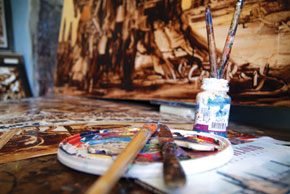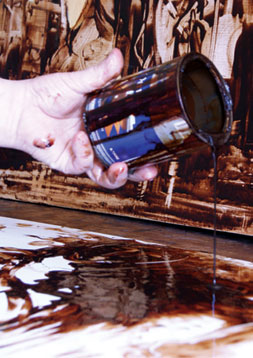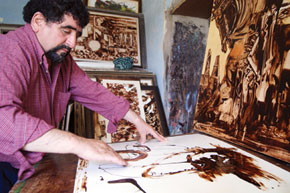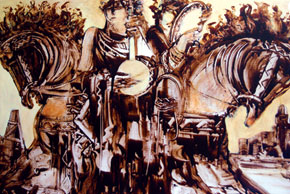
As a young boy, Sabir, while playing alone in the yard at his home in Borchali (a region of Georgia, now known as Kvemo Kartli and home to many Azerbaijanis) found a small jar of the strange liquid brought from the Azerbaijani spa of Naftalan by his parents. He took a good look at the jar and finally decided to pour its contests into the palm of his hand. What came out was a brown liquid with a thick smell. Not knowing what to do with it, Sabir spread it over the wall of his house, like a painter. He ‘spread’ it into a picture of trees and horses. Later, when his grandma returned, she saw a terrible mess on the wall and scolded little Sabir. She wasn’t to know that she had scolded the discoverer of oil painting.
Sabir Chopuroglu is now in his fifties. He uses real oil, not oil paints. The studio where he works is littered with paintings all with the same fragrance – of oil. He took seriously to this distinctive medium almost 15 years ago, after the novice painter visited Azerbaijan from Borchali. He had heard a lot about Absheron, the oil-rich region of Azerbaijan, and embarked on a search for new subjects for paintings. It seems that he found what he wanted. Some time after his visit to the Baku suburb of Ramana with its nodding donkey oil wells, Sabir decided to live in Baku and create paintings as long as he received inspiration from the oil.
Wow, there are so many paintings! Where does all the inspiration come from?
Our first question as we entered the studio to meet the painter in person.
From the oil of course – he smiles.
Master class
The studio we entered really was filled with paintings. A small table, covered in brown spots could be seen among dozens of canvases, a small sofa and an old radio set hanging on the wall – these set the tone of the room. Sabir prepared some tea for us from his own recipe - rosehip tea. As we sipped, he gave us a master class. He took a jar with oil, sniffed it, then spread some paper on the table, dipped his fingers into the jar and started… Painting with his fingers, he seemed to be working miracles – one blink and an image had appeared. Painting a woman holding a kamancha, he told us his story at the same time…
The best oil for painting
He first really discovered painting in oil in 1989 in Ramana while seeking those nodding donkey wells for his sketches of oily Baku. Near the wells a puddle of oil caught his eye for the beauty of the landscape in reflection. He had an urge to scoop the stuff up with his hands, to feel the oil and to understand the value of the ‘black gold’ that rules a whole world.
I’d never thought about the oil until I went to Ramana. When I felt it on my hands it became clear to me that something connected us. Later I realized the reason – I feel the oil in my paintings better than oil paints.
And Sabir really does paint with his fingers, not a brush. A wide table, a jar of thick oil, coated paper and a little of fantasy – all he needs for the next painting. Having mastered the technique of painting in a flammable liquid, he began adding a lacquer – to make the paintings dry faster. Over the years he has become more adept in this technique. But wherever he goes to collect the oil that is sucked up by Absheron’s nodding donkeys, the best for him is in Ramana.
Oil inspiration
Interestingly, a drawing takes less time than thinking up the idea. Sometimes it takes years for an idea to mature; they originate, Sabir says, sometimes spontaneously, sometimes from books on history or literature, or from the people around him.

I remember, a friend of mine giving me an old wall calendar; the paper quality was perfect for painting on the reverse. On the first page I painted some nodding donkey wells, then Absheron’s landscapes which, I think, are perfect for painting. Then I painted some horses. You know, that’s another of my favourite themes, whether for painting or reading…it stems from my childhood when my grandfather kept horses. I fell in love with them and always dreamt of having my own. For me the horse is a symbol of power and I associate it with justice for Karabakh.
The best is also the most difficult
Old Baku also frequently appears in Sabir’s paintings. He can paint forever anything connected with the city: Maiden Tower, the oil wells, the architecture, the fortress, Silk Way, and caravans, as well antique carpet designs, traditional musical instruments - the saz and kamancha are often to be found. However, Sabir thinks that the best theme is also the most difficult - the horse.
I have many paintings of horses. Most of them I keep and they are not for sale. When I look back at them I feel the happiness of my childhood. Of course, the colour of the oil suits that of many horses. It gives a greater reality and spirituality to the painting.
The ever first oil-painter
It is a fact that Sabir’s first painting in oil was of horses. This picture still adorns his collection of hundreds of works. Since taking up oil-painting fifteen years ago, he has completed some 1,000 paintings. The modest painter considers just about half of them to be professional.
In general I paint for myself. You see that I am working in very modest conditions that are not so comfortable. But this is enough for me. I’m surrounded by my children – by my paintings - and it makes me feel alive.
He claims to be the first Azerbaijani artist to use oil as paint. He declares that no artist before him had done so. Even now, he adds, there are few painters who paint in oil.
It is hardly common now, is it?! Oil-painting demands skill, patience, love and, of course, constancy. I know a number of artists, even some colleagues, who were once drawn to it, but couldn’t continue. You have to feel the oil with your fingers; you have to draw with the fingers. Few people can do it.
First paintings bought by foreigners
Germany will host an exhibition of Sabir’s oil paintings next September; both old and new works will be on display. And it was Germany that launched him into the public eye with his very first exhibition.
It was at the end of the 90s. Some of my works were presented there. I remember their artists were looking at the paintings with great curiosity; they were surprised to learn about their origin; and so my first works were bought by foreign art lovers.
Sabir recently completed an oil-painting dedicated to the Eurovision Song Contest that was held in Baku in May this year. He has no intention of changing his style and hopes that his son, who is also an artist, will continue his special art. So, as there is plenty of black gold in Baku, you may be sure that those golden colours will shine forth from his paintings for years to come, passing from generation to generation.
Sabir Chopuroglu is now in his fifties. He uses real oil, not oil paints. The studio where he works is littered with paintings all with the same fragrance – of oil. He took seriously to this distinctive medium almost 15 years ago, after the novice painter visited Azerbaijan from Borchali. He had heard a lot about Absheron, the oil-rich region of Azerbaijan, and embarked on a search for new subjects for paintings. It seems that he found what he wanted. Some time after his visit to the Baku suburb of Ramana with its nodding donkey oil wells, Sabir decided to live in Baku and create paintings as long as he received inspiration from the oil.
Wow, there are so many paintings! Where does all the inspiration come from?
Our first question as we entered the studio to meet the painter in person.
From the oil of course – he smiles.
Master class
The studio we entered really was filled with paintings. A small table, covered in brown spots could be seen among dozens of canvases, a small sofa and an old radio set hanging on the wall – these set the tone of the room. Sabir prepared some tea for us from his own recipe - rosehip tea. As we sipped, he gave us a master class. He took a jar with oil, sniffed it, then spread some paper on the table, dipped his fingers into the jar and started… Painting with his fingers, he seemed to be working miracles – one blink and an image had appeared. Painting a woman holding a kamancha, he told us his story at the same time…
The best oil for painting
He first really discovered painting in oil in 1989 in Ramana while seeking those nodding donkey wells for his sketches of oily Baku. Near the wells a puddle of oil caught his eye for the beauty of the landscape in reflection. He had an urge to scoop the stuff up with his hands, to feel the oil and to understand the value of the ‘black gold’ that rules a whole world.
I’d never thought about the oil until I went to Ramana. When I felt it on my hands it became clear to me that something connected us. Later I realized the reason – I feel the oil in my paintings better than oil paints.
And Sabir really does paint with his fingers, not a brush. A wide table, a jar of thick oil, coated paper and a little of fantasy – all he needs for the next painting. Having mastered the technique of painting in a flammable liquid, he began adding a lacquer – to make the paintings dry faster. Over the years he has become more adept in this technique. But wherever he goes to collect the oil that is sucked up by Absheron’s nodding donkeys, the best for him is in Ramana.
Oil inspiration
Interestingly, a drawing takes less time than thinking up the idea. Sometimes it takes years for an idea to mature; they originate, Sabir says, sometimes spontaneously, sometimes from books on history or literature, or from the people around him.

I remember, a friend of mine giving me an old wall calendar; the paper quality was perfect for painting on the reverse. On the first page I painted some nodding donkey wells, then Absheron’s landscapes which, I think, are perfect for painting. Then I painted some horses. You know, that’s another of my favourite themes, whether for painting or reading…it stems from my childhood when my grandfather kept horses. I fell in love with them and always dreamt of having my own. For me the horse is a symbol of power and I associate it with justice for Karabakh.
The best is also the most difficult
Old Baku also frequently appears in Sabir’s paintings. He can paint forever anything connected with the city: Maiden Tower, the oil wells, the architecture, the fortress, Silk Way, and caravans, as well antique carpet designs, traditional musical instruments - the saz and kamancha are often to be found. However, Sabir thinks that the best theme is also the most difficult - the horse.
I have many paintings of horses. Most of them I keep and they are not for sale. When I look back at them I feel the happiness of my childhood. Of course, the colour of the oil suits that of many horses. It gives a greater reality and spirituality to the painting.
The ever first oil-painter
It is a fact that Sabir’s first painting in oil was of horses. This picture still adorns his collection of hundreds of works. Since taking up oil-painting fifteen years ago, he has completed some 1,000 paintings. The modest painter considers just about half of them to be professional.
In general I paint for myself. You see that I am working in very modest conditions that are not so comfortable. But this is enough for me. I’m surrounded by my children – by my paintings - and it makes me feel alive.
He claims to be the first Azerbaijani artist to use oil as paint. He declares that no artist before him had done so. Even now, he adds, there are few painters who paint in oil.
It is hardly common now, is it?! Oil-painting demands skill, patience, love and, of course, constancy. I know a number of artists, even some colleagues, who were once drawn to it, but couldn’t continue. You have to feel the oil with your fingers; you have to draw with the fingers. Few people can do it.
First paintings bought by foreigners
Germany will host an exhibition of Sabir’s oil paintings next September; both old and new works will be on display. And it was Germany that launched him into the public eye with his very first exhibition.
It was at the end of the 90s. Some of my works were presented there. I remember their artists were looking at the paintings with great curiosity; they were surprised to learn about their origin; and so my first works were bought by foreign art lovers.
Sabir recently completed an oil-painting dedicated to the Eurovision Song Contest that was held in Baku in May this year. He has no intention of changing his style and hopes that his son, who is also an artist, will continue his special art. So, as there is plenty of black gold in Baku, you may be sure that those golden colours will shine forth from his paintings for years to come, passing from generation to generation.




